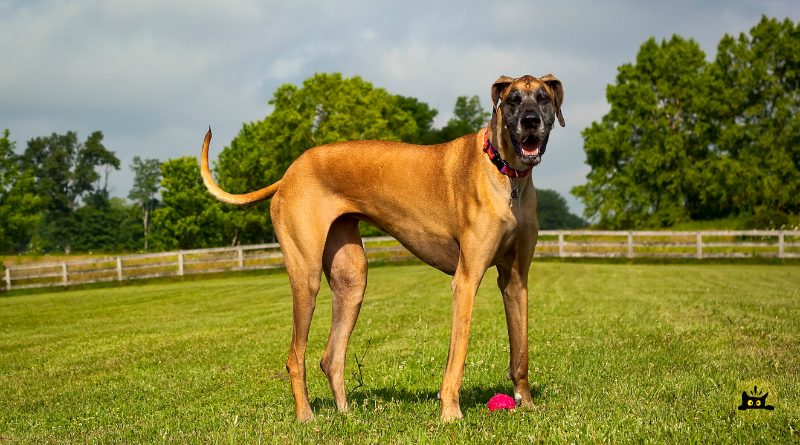Great Danes stand out for their elegant stature and affectionate nature. Adults typically reach twenty-eight to thirty inches at the shoulder and weigh one hundred ten to one hundred eighty pounds. These dogs live around seven to ten years. Their gentle disposition and watchful eyes make them cherished companions. Great Dane care revolves around ensuring a balanced diet, safe exercise, and consistent mental engagement suitable for their size and temperament. VCA Animal Hospitals emphasizes that ample indoor space and soft bedding support joint comfort in large breeds.
Physical Traits
Great Danes display a short smooth coat in colors such as fawn, blue, black, brindle, harlequin, and mantle as noted by WebMD Pets. Their skin lies close to the body, revealing well-defined muscles and a deep chest. Harlequin variants may need extra sun protection due to lighter patches. Weekly brushing with a soft-bristle brush removes loose hair and spreads natural oils for a healthy shine. Ears left natural require gentle cleaning to prevent wax buildup. Their long tapering tail often wags slowly but enthusiastically. Despite their size, shedding remains moderate and grooming is straightforward.
Temperament
These gentle giants balance calmness with friendly curiosity. They form strong bonds and often follow family members from room to room seeking company. Early puppy group classes support social skills and reduce anxiety around strangers, according to VCA Animal Hospitals. Great Danes respond best to reward-based training using praise, treats, and short play sessions. Close supervision around small children prevents accidental knocks, given the dog’s size. Their keen intelligence thrives with regular mental challenges, while their loyalty makes them protective without aggressiveness.
Health Watch Points
Great Danes have a lifespan of seven to ten years, and vigilant monitoring for common conditions can extend their active life. Regular veterinary checkups allow early detection of issues and support preventive care.
Bloat (stomach twist trapping gas)
Bloat occurs when the stomach fills with gas and rotates on itself, cutting off blood flow. Signs include a hard, swollen belly, restlessness, drooling, and repeated attempts to vomit without results. This emergency demands immediate veterinary intervention. To reduce risk, offer smaller, more frequent meals, avoid vigorous play around mealtimes, and maintain a calm feeding routine as advised by VCA Animal Hospitals. Feeding bowls at floor level rather than raised stands also lowers risk.
Joint and Heart Conditions
Great Danes face hip dysplasia (abnormal hip joint formation) and HCM (thickening of heart muscle). Early signs of joint pain include stiffness after rest, reluctance to climb stairs, or difficulty rising. Maintaining a healthy weight and providing joint supplements rich in glucosamine and chondroitin support mobility under guidance from the National Animal Supplement Council. Heart screening via ultrasound can catch HCM before symptoms such as fatigue or coughing appear.
Essential Care
Nutrition is key to Great Dane care. Puppies thrive on large-breed growth formulas that manage bone and joint development. Adult dogs benefit from high-quality protein and moderate calories to prevent excess weight that strains joints. The National Animal Supplement Council notes that fish oil boosts coat sheen and joint health when dosed correctly. Divide daily food into two or three meals and keep fresh water available at all times. VCA Animal Hospitals also recommends non-slip mats under feeding areas to reduce joint strain. Gentle stretching routines before walks support flexibility and muscle tone, as suggested by WebMD Pets.
Enrichment
Interactive toys, puzzle feeders, and treat dispensers cater to their problem-solving instincts while slowing down eager eaters. Short training games teaching basic commands or fun behaviors reinforce bonds and mental agility. Low-impact exercises such as swimming build cardiovascular fitness without joint stress. Scheduled social visits with calm dogs support emotional well-being. Aim for twenty to thirty minute enrichment sessions daily to prevent boredom and discourage unwanted behaviors like chewing furniture.
What to Do
Monitor appetite, energy level, and bathroom habits for sudden changes. A drop in playfulness or hesitance on walks may indicate discomfort. For feeding, use a slow-feed bowl or scatter kibble across a flat surface to reduce air gulping. Offer joint supplements under veterinary advice and track improvements over weeks. Schedule annual heart and joint assessments at a VCA Animal Hospital clinic. Enroll in group training or work with a certified trainer to maintain social skills and mental stimulation.
Sources : National Animal Supplement Council, VCA Animal Hospitals, WebMD Pets
For more on dog nutrition, check our large breed feeding guide: Chihuahual Dog Breed Guide

